Investigation of Thermal Sensing in Fluoroindate Yb3+/Er3+ Co-Doped Optical Fiber
Abstract
1. Introduction
2. Materials and Methods
3. Results and Discussion
3.1. Fluoroindate Glass
3.2. Fluoroindate Optical Fiber
4. Conclusions
Author Contributions
Funding
Institutional Review Board Statement
Informed Consent Statement
Data Availability Statement
Conflicts of Interest
References
- Wu, Y.; Zhang, Z.; Suo, H.; Zhao, X.; Guo, C. 808 nm light triggered up-conversion optical nano-thermometer YPO4:Nd3+/Yb3+/Er3+ based on FIR technology. J. Lumin. 2019, 214, 116578. [Google Scholar] [CrossRef]
- Zhao, Y.; Wang, X.; Zhang, Y.; Li, Y.; Yao, X. Optical temperature sensing of up-conversion luminescent materials: Fundamentals and progress. J. Alloys Compd. 2020, 817, 152691. [Google Scholar] [CrossRef]
- Wang, C.; Jin, Y.; Zhang, R.; Yao, Q.; Hu, Y. A review and outlook of ratiometric optical thermometer based on thermally coupled levels and non-thermally coupled levels. J. Alloys Compd. 2022, 894, 162494. [Google Scholar] [CrossRef]
- Pavani, K.; Nascimento, J.D.; Jakka, S.; Carmo, F.D.; Sales, A.; Soares, M.; Graça, M.; de Aquino, F.; Gouveia, D.; Sombra, A. Analogy of different optical temperature sensing techniques in LaNbO4:Er3+/Yb3+ phosphor. J. Lumin. 2021, 235, 117992. [Google Scholar] [CrossRef]
- Fang, S.; Li, Y.; Cai, P.; Zhu, Q.; Zhai, Y.; Zhang, H.; Cai, M.; Lang, T.; Wang, L. Strong electron–phonon coupling of Cr3+ ion provides an opportunity for superior sensitivity cryogenic sensing. J. Opt. Laser Technol. 2023, 158, 108844. [Google Scholar] [CrossRef]
- Chen, J.; Guo, J.; Chen, Y.; Peng, X.; Ashraf, G.A.; Guo, H. Up-conversion properties of Ba3Lu2Zn5O11:Yb3+,Er3+ phosphors for optical thermometer based on FIR technique. J. Lumin. 2021, 238, 118294. [Google Scholar] [CrossRef]
- Yang, K.; Shen, Y.; He, K.; Zhang, T.; Xu, R.; Zhao, S.; Chen, L.; Xu, S. An optical fiber temperature sensor based on fluorescence intensity ratio used for real-time monitoring of chemical reactions. Ceram. Int. 2021, 47, 33537–33543. [Google Scholar] [CrossRef]
- Kochanowicz, M.; Zmojda, J.; Baranowska, A.; Kuwik, M.; Starzyk, B.; Lesniak, M.; Miluski, P.; Pisarski, W.; Pisarska, J.; Dorosz, J.; et al. Fluoroindate Glass Co-Doped with Yb3+/Ho3+ as a 2.85 μm Luminescent Source for MID-IR Sensing. Sensors 2021, 21, 2155. [Google Scholar] [CrossRef]
- She, L.; Qi, Q.; Zhang, P.; Dai, S.; Jiang, Y.; Sun, W.; Jia, S.; Wang, S.; Brambilla, G.; Wang, P. Mid-infrared fluoroindate glass long-period fiber grating by femtosecond laser inscription. J. Infrared 2021, 116, 103808. [Google Scholar] [CrossRef]
- Haro-González, P.; Martín, I.R.; Capuj, N.E.; Lahoz, F. Optical amplification by upconversion in Tm–Yb fluoroindate glass. Opt. Mater. 2010, 32, 1349–1351. [Google Scholar] [CrossRef]
- Zhang, Y.; Xiao, Z.; Lei, H.; Zeng, L.; Tang, J. Er3+/Yb3+ co-doped tellurite glasses for optical fiber thermometry upon UV and NIR excitations. J. Lumin. 2019, 212, 61–68. [Google Scholar] [CrossRef]
- Zhu, X.; Peyghambarian, N. High-Power ZBLAN Glass Fiber Lasers: Review and Prospect. Adv. Optoelectron. 2010, 2010, 501956. [Google Scholar] [CrossRef]
- Starzyk, B.; Lesniak, M.; Miranda, G.L.J.; Kochanowicz, M.; Kuwik, M.; Zmojda, J.M.; Miluski, P.; Baranowska, A.; Dorosz, J.; Pisarski, W.A.; et al. Spectroscopic Properties of Fluoroindate Glass and Glass-Ceramics Doped with Eu3+ Ions. In Fiber Lasers and Glass Photonics: Materials through Applications III; SPIE: Bellingham, WA, USA, 2022; Volume 12142, pp. 318–322. [Google Scholar] [CrossRef]
- Kochanowicz, M.; Lesniak, M.; Zmojda, J.; Miluski, P.; Baranowska, A.; Ragin, T.; Kuwik, M.; Pisarski, W.A.; Pisarska, J.; Dorosz, J.; et al. Structure, luminescence and energy transfer of fluoroindate glasses co-doped with Er3+/Ho3+. Ceram. Int. 2020, 46, 26403–26409. [Google Scholar] [CrossRef]
- Jimenez, G.L.; Shrestha, B.; Porter, T.; Starzyk, B.; Lesniak, M.; Kuwik, M.; Kochanowicz, M.; Szumera, M.; Lisiecki, R.; Dorosz, D. Highly efficient green up-conversion emission from fluoroindate glass nanoparticles functionalized with a biocompatible polymer. RSC Adv. 2022, 12, 20074–20079. [Google Scholar] [CrossRef]
- Ma, S.; Xu, Y.; Pang, Y.; Zhao, X.; Li, Y.; Qin, Z.; Liu, Z.; Lu, P.; Bao, X. Optical Fiber Sensors for High-Temperature Monitoring: A Review. Sensors 2022, 22, 5722. [Google Scholar] [CrossRef] [PubMed]
- Liu, X.; Wang, J.; Lei, R.; Zhao, S.; Huang, F.; Deng, D.; Xu, S. Comparison study on the different strategies designed for ratiometric luminescence thermometry in Er3+/Yb3+: SrMoO4 phosphor. Sens. Actuators A Phys. 2020, 315, 112287. [Google Scholar] [CrossRef]
- Wi, J.-H.; Park, S.-G.; Shim, Y.-S.; Lee, K.; Jung, J.-Y. Rare-Earth-Doped Barium Molybdate Up-Conversion Phosphor with Potential Application in Optical Temperature Sensing. Materials 2022, 15, 7917. [Google Scholar] [CrossRef]
- Liu, H.; Jian, X.; Liu, M.; Wang, K.; Bai, G.; Zhang, Y. Investigation on the upconversion luminescence and ratiometric thermal sensing of SrWO4:Yb3+/RE3+ (RE = Ho/Er) phosphors. RSC Adv. 2021, 11, 36689–36697. [Google Scholar] [CrossRef]
- Lihui, H.; Xingren, L.; Wu, X.; Baojiu, C.; Jiuling, L. Infrared and visible luminescence properties Er3+ of Yb3+ and ions codoped Ca3Al2Ge3O12 glass under 978 nm diode laser excitation. J. Appl. Phys. 2001, 90, 5554. [Google Scholar] [CrossRef]
- Brites, C.D.S.; Balabhadra, S.; Carlos, L.D. Lanthanide-Based Thermometers: At the Cutting-Edge of Luminescence Thermometry. Adv. Opt. Mater. 2019, 7, 1801239. [Google Scholar] [CrossRef]
- Ansari, A.A.; Parchur, A.K.; Nazeeruddin, M.K.; Tavakoli, M.M. Luminescent lanthanide nanocomposites in thermometry: Chemistry of dopant ions and host matrices. Coordin. Chem. Rev. 2021, 444, 214040. [Google Scholar] [CrossRef]
- Łukaszewicz, M.; Klimesz, B.; Szmalenberg, A.; Ptak, M.; Lisiecki, R. Neodymium-doped germanotellurite glasses for laser materials and temperature sensing. J. Alloys Compd. 2021, 860, 157923. [Google Scholar] [CrossRef]
- Orlovskii, Y.V.; Basiev, T.T.; Vorob’ev, I.N.; Orlovskaya, E.O.; Barnes, N.P.; Mirov, S.B. Temperature dependencies of excited states lifetimes and relaxation rates of 3–5 phonon (4–6 μm) transitions in the YAG, LuAG and YLF crystals doped with trivalent holmium, thulium, and erbium. Opt. Mater. 2022, 18, 355–365. [Google Scholar] [CrossRef]
- Lei, H.; Zeng, L.; Lin, F.; Qin, Z.; Li, G.; Tang, J. Yb3+/Er3+ incorporated fluorotellurite glasses with varying TeO2 content for optical temperature sensing based on upconverted FIR technique. J. Lumin. 2021, 229, 117677. [Google Scholar] [CrossRef]
- Feng, L.; Lai, B.; Wang, J.; Du, G.; Su, Q. Spectroscopic properties of Er3+ in a oxyfluoride glass and upconversion and temperature sensor behaviour of Er3+/Yb3+-codoped oxyfluoride glass. J. Lumin. 2010, 130, 2418–2423. [Google Scholar] [CrossRef]
- Yang, K.; Xu, R.; Meng, Q.; Chen, L.; Zhao, S.; Shen, Y.; Xu, S. Er3+/Yb3+ co-doped TeO2–ZnO–ZnF2–La2O3 glass with a high fluorescence intensity ratio for an all-fiber temperature sensor. J. Lumin. 2020, 222, 117145. [Google Scholar] [CrossRef]
- Maciel, G.S.; Menezes, L.; Gomes, A.; De Araujo, C.; Messaddeq, Y.; Florez, A.; Aegerter, A. Temperature sensor based on frequency upconversion in Er3+—Doped fluoroindate glass. IEEE Photon. Technol. Lett. 1995, 7, 1474–1476. [Google Scholar] [CrossRef]
- Dos Santos, P.V.; Araujo, M.T.D.; Gouveia-Neto, A.; Neto, J.; Sombra, A. Optical Thermometry Through Infrared Excited Upconversion Fluorescence Emission in Er3+- and Er3+–Yb3+-doped Chalcogenide Glasses. IEEE J. Quant. Electron. 1999, 35, 395–399. [Google Scholar] [CrossRef]
- Sui, G.; Li, X.; Cheng, L.; Sun, J.; Zhang, J.; Zhang, X.; Xia, H.; Hua, R.; Chen, B. Theoretical evaluation on laser cooling of ZBLAN:Er3+ glass with in situ optical temperature sensing. Sens. Actuators B Chem. 2015, 220, 362–369. [Google Scholar] [CrossRef]
- Bao, R.; An, N.; Ye, L.; Wang, L.-G. Wide-range temperature sensor based on enhanced up-conversion luminescence in Er3+/Yb3+ co-doped Y2O3 crystal fiber. Opt. Fiber Technol. 2019, 52, 101989. [Google Scholar] [CrossRef]
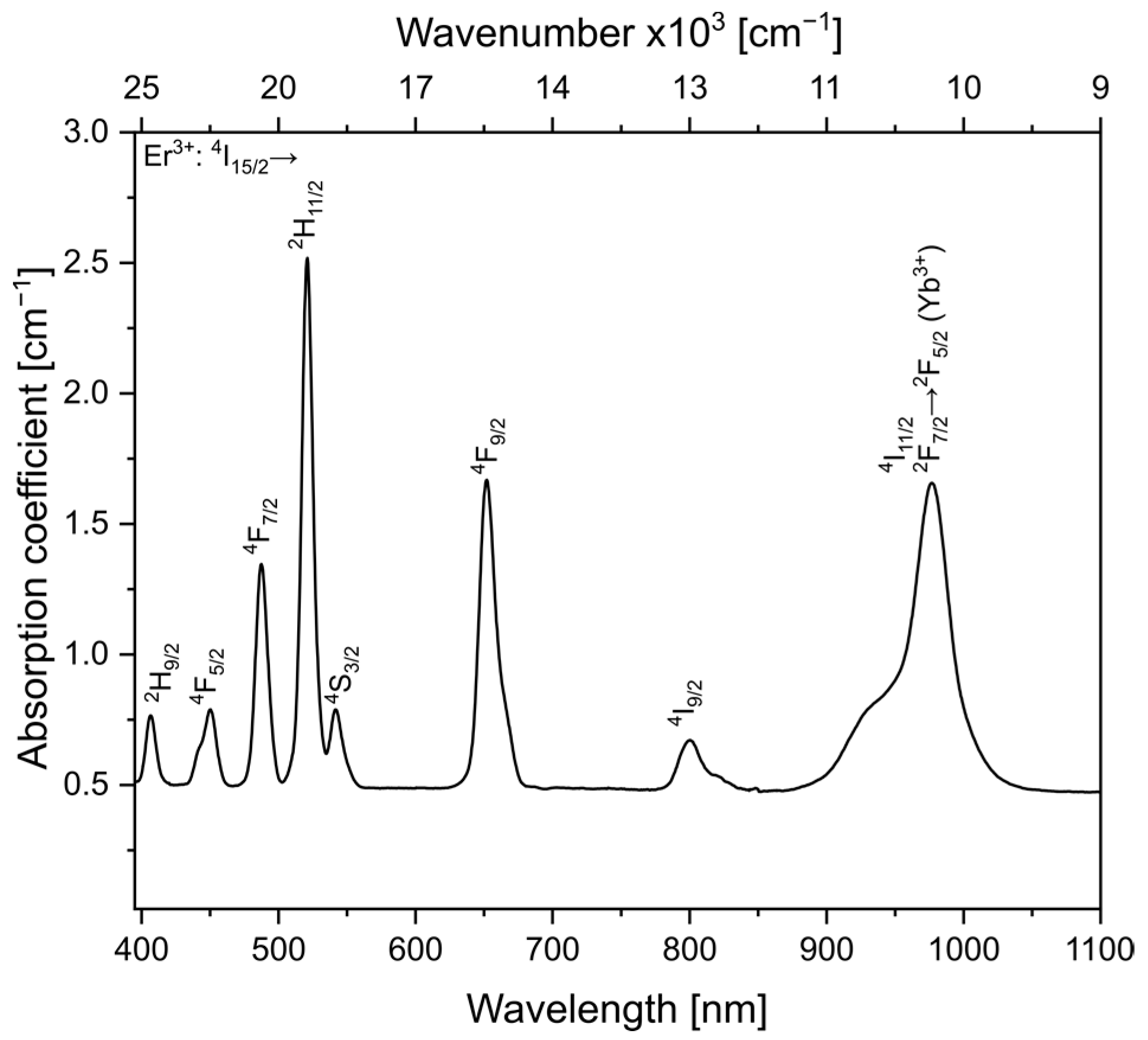

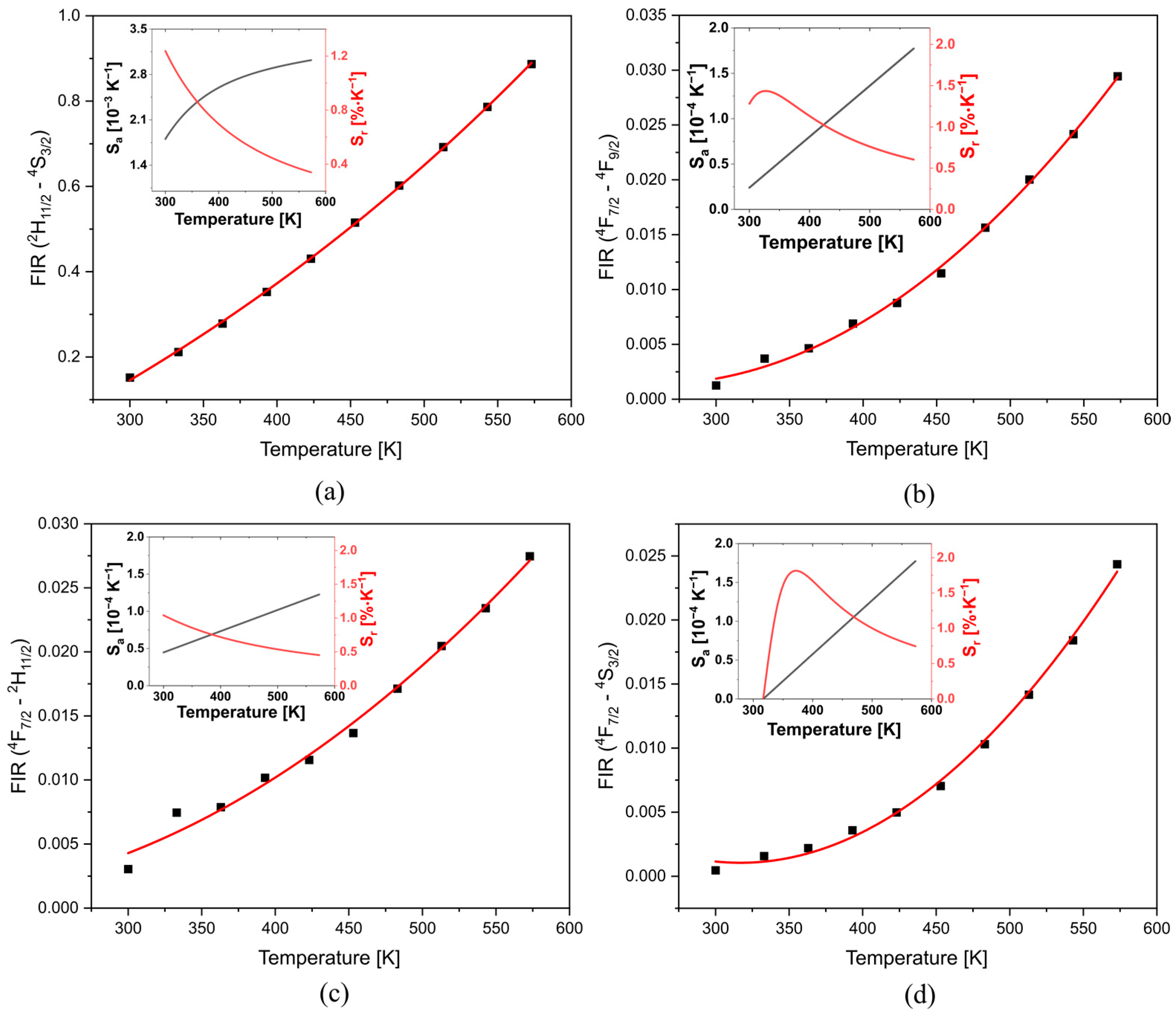
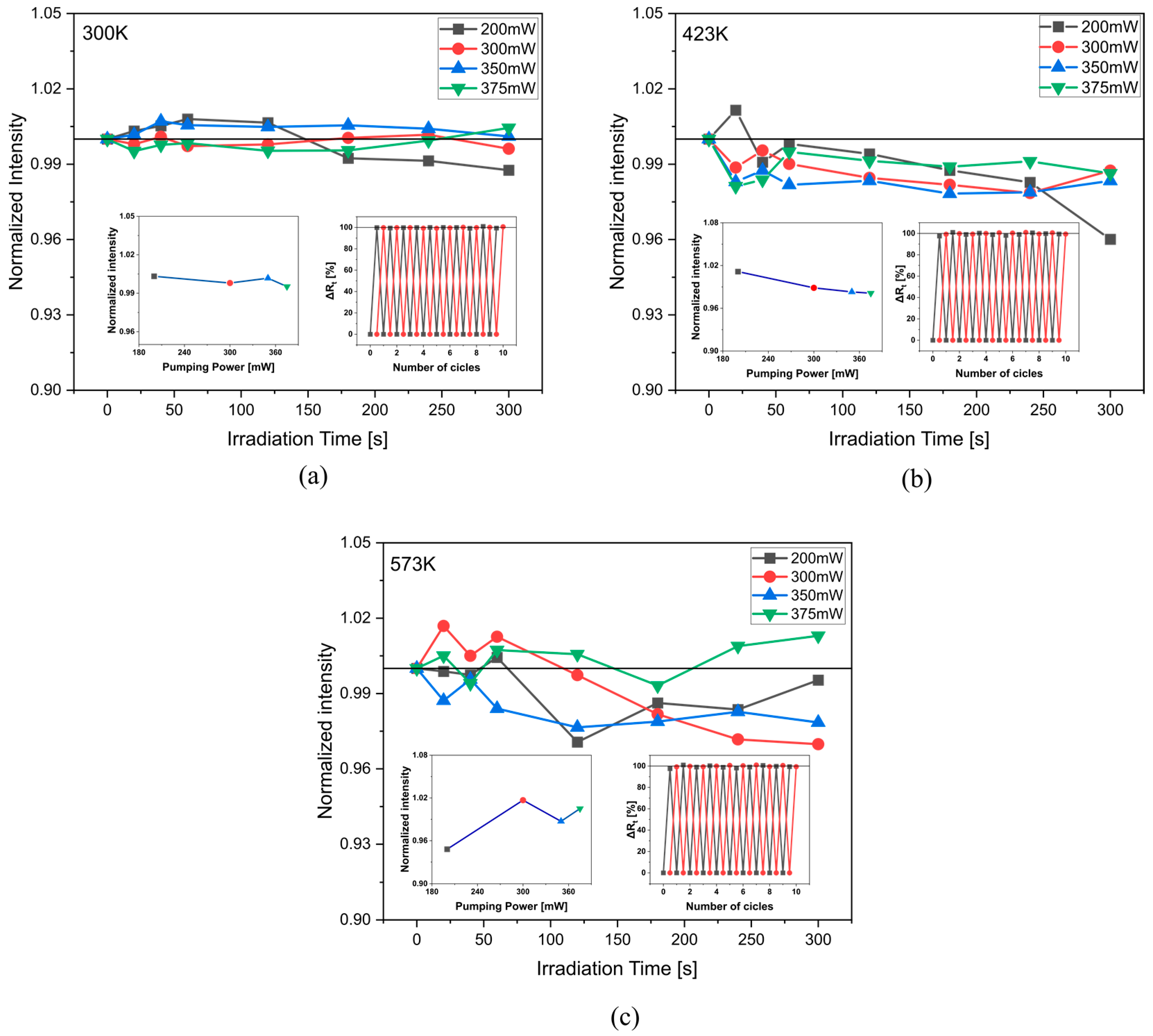
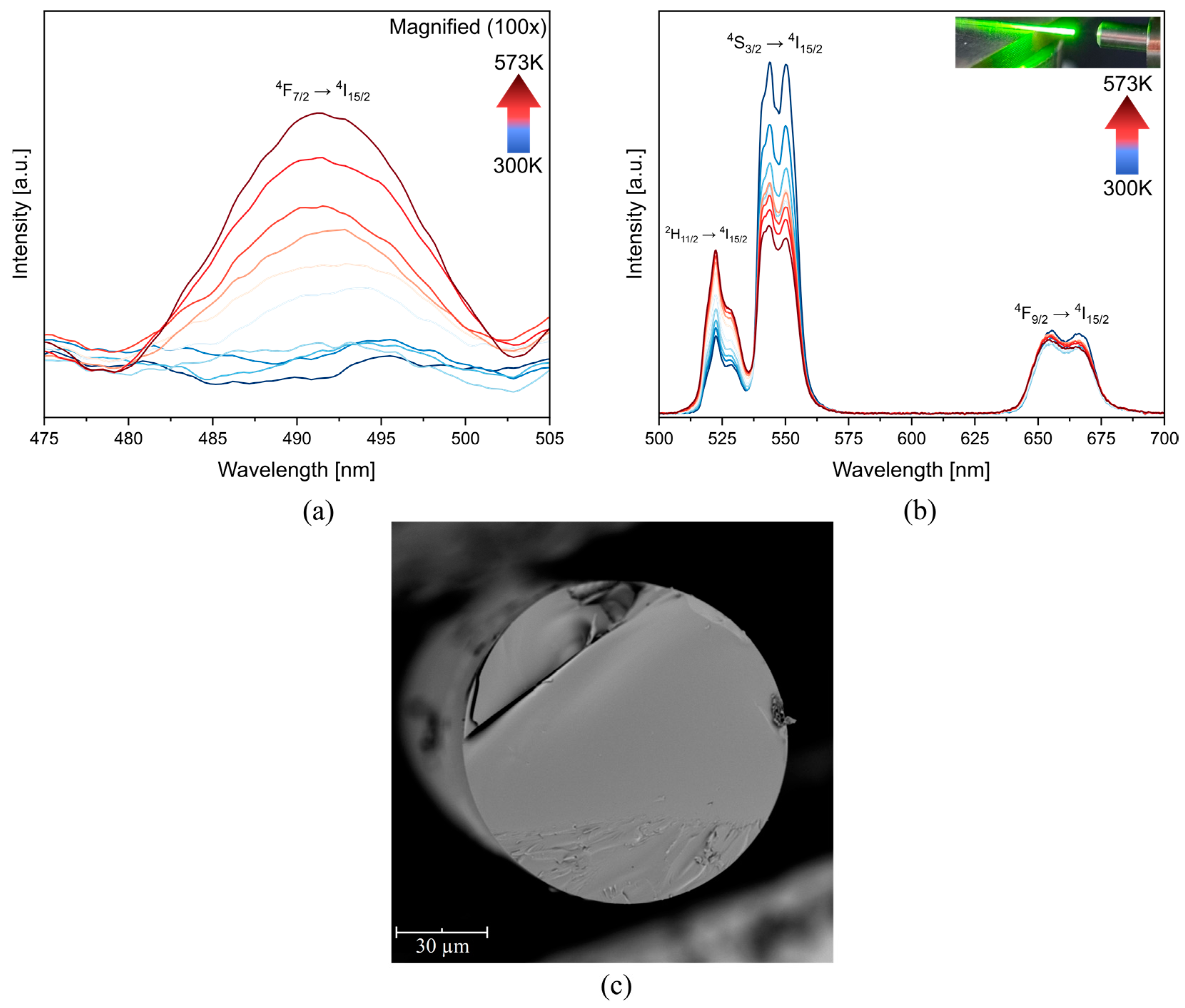
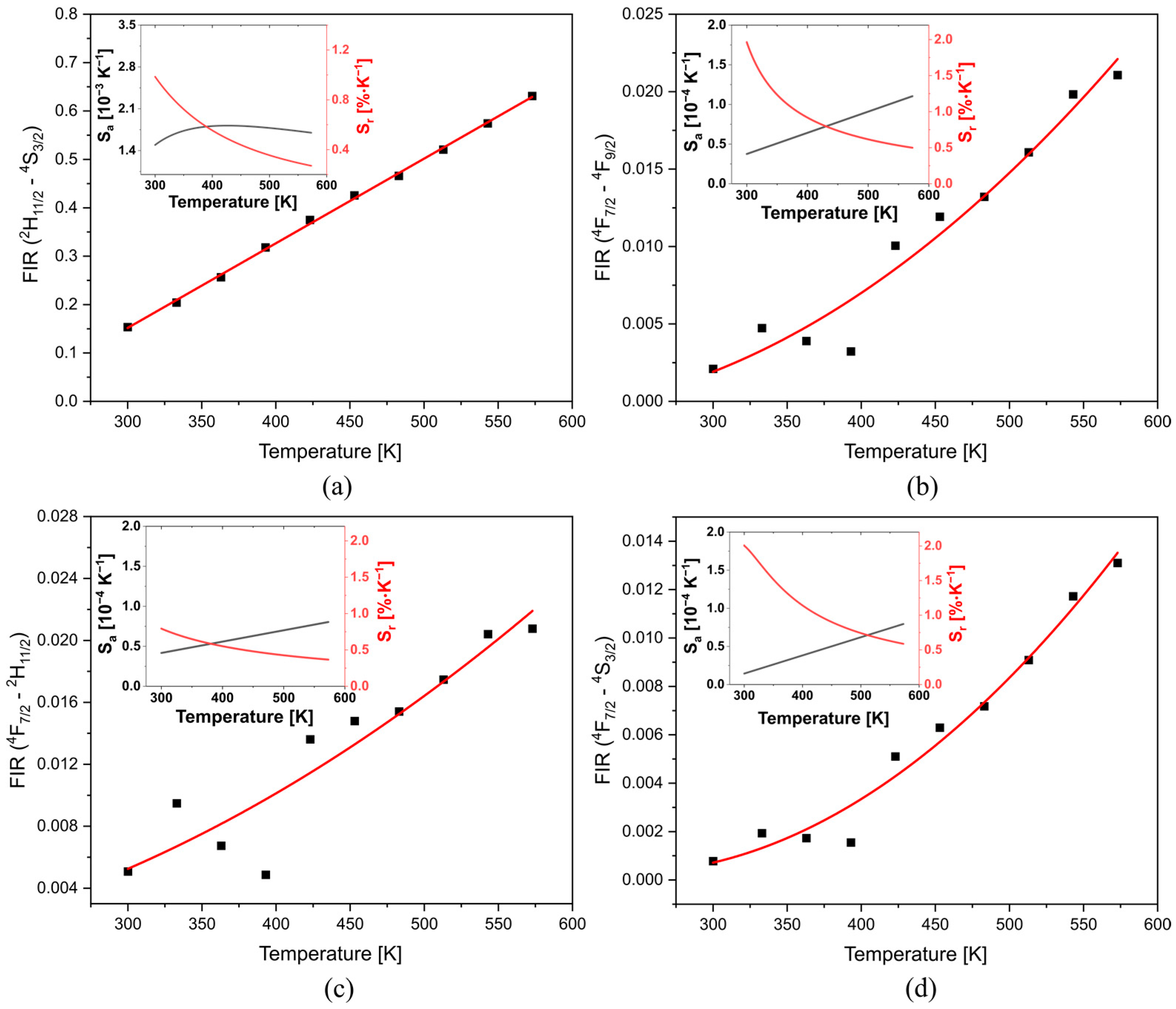
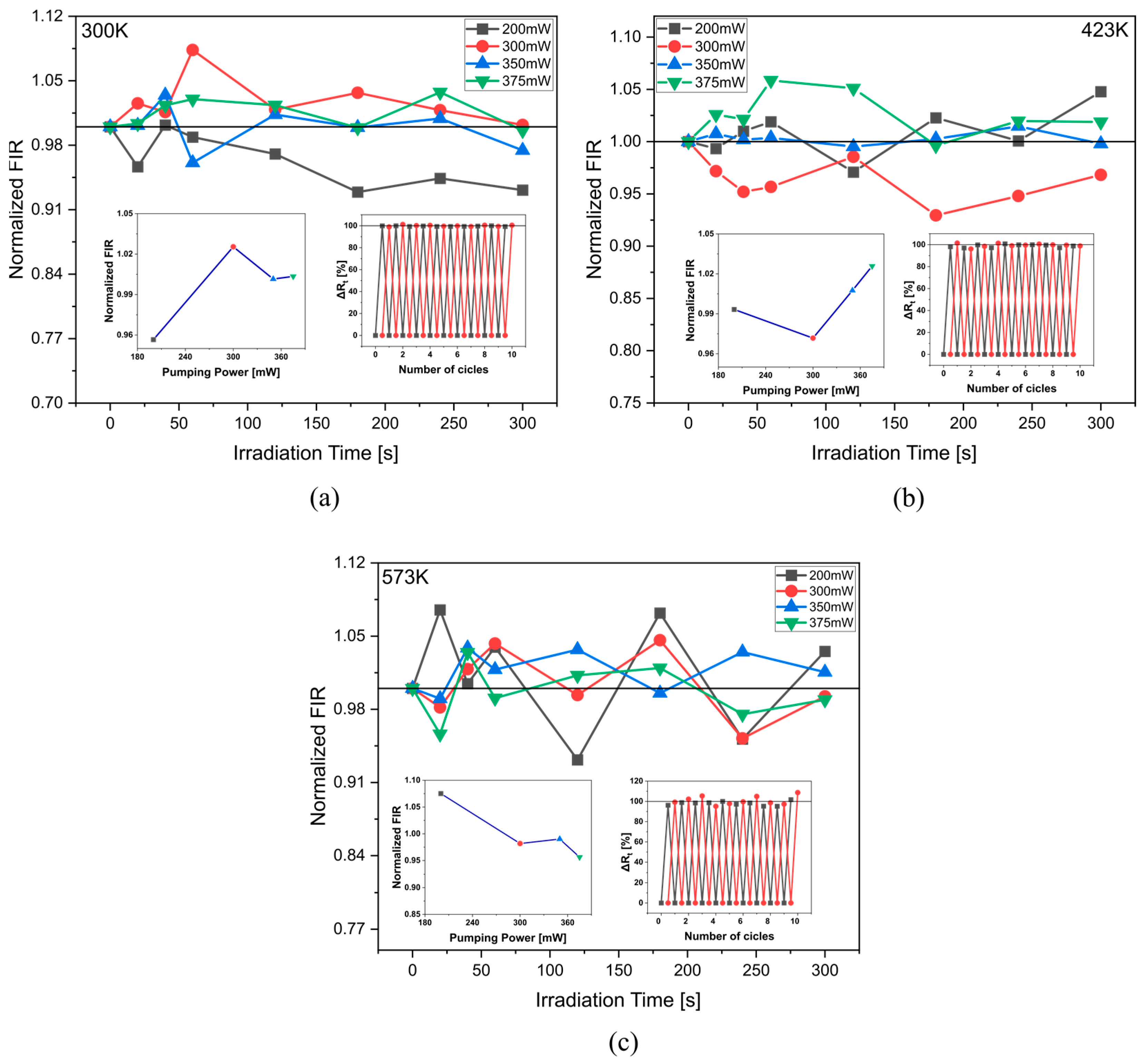
| Glass | λexc [nm] | ΔE [cm−1] | Transition | Sa [10−3 K−1] | Sr [%K−1] | Ref. |
|---|---|---|---|---|---|---|
| InF3 | 980 | 780 | 2H11/2—4S3/2 | 3.00@573 K | 1.24@300 K | This work |
| InF3 | 980 | --- | 4F7/2—7F9/2 | 0.18@573 K | 1.44@325 K | This work |
| InF3 | 980 | --- | 4F7/2—2H11/2 | 0.12@573 K | 1.04@300 K | This work |
| InF3 | 980 | --- | 4F7/2—4S3/2 | 0.18@573 K | 1.81@372 K | This work |
| TeO2-Al2O3-NaF-CaF2 | 980 | 767 | 2H11/2—4S3/2 | 7.45@548 K | 1.25@298 K | [25] |
| Silicate glass | 980 | 719 | 2H11/2—4S3/2 | 2.70@513 K | 1.17@298 K | [26] |
| TeO2-BaF2-GdF3 | 980 | 771 | 2H11/2—4S3/2 | 6.84@548 K | 1.25@298 K | [11] |
| TeO2-ZnO-ZnF2-La2O3 | 980 | 745 | 2H11/2—4S3/2 | 5.97@547 K | 1.21@298 K | [27] |
| Fluoride glass | 1480 | 769 | 2H11/2—4S3/2 | 4.00@548 K | 1.25@298 K | [28] |
| Chalcogenide glass | 1060 | 645 | 2H11/2—4S3/2 | 5.20@493 K | 1.05@298 K | [29] |
| ZBLAN | 337 | 732 | 2H11/2—4S3/2 | 4.60@527 K | 1.19@298 K | [30] |
Disclaimer/Publisher’s Note: The statements, opinions and data contained in all publications are solely those of the individual author(s) and contributor(s) and not of MDPI and/or the editor(s). MDPI and/or the editor(s) disclaim responsibility for any injury to people or property resulting from any ideas, methods, instructions or products referred to in the content. |
© 2023 by the authors. Licensee MDPI, Basel, Switzerland. This article is an open access article distributed under the terms and conditions of the Creative Commons Attribution (CC BY) license (https://creativecommons.org/licenses/by/4.0/).
Share and Cite
Starzyk, B.; Jimenez, G.L.; Kochanowicz, M.; Kuwik, M.; Żmojda, J.; Miluski, P.; Baranowska, A.; Dorosz, J.; Pisarski, W.; Pisarska, J.; et al. Investigation of Thermal Sensing in Fluoroindate Yb3+/Er3+ Co-Doped Optical Fiber. Materials 2023, 16, 2139. https://doi.org/10.3390/ma16062139
Starzyk B, Jimenez GL, Kochanowicz M, Kuwik M, Żmojda J, Miluski P, Baranowska A, Dorosz J, Pisarski W, Pisarska J, et al. Investigation of Thermal Sensing in Fluoroindate Yb3+/Er3+ Co-Doped Optical Fiber. Materials. 2023; 16(6):2139. https://doi.org/10.3390/ma16062139
Chicago/Turabian StyleStarzyk, Bartłomiej, Gloria Lesly Jimenez, Marcin Kochanowicz, Marta Kuwik, Jacek Żmojda, Piotr Miluski, Agata Baranowska, Jan Dorosz, Wojciech Pisarski, Joanna Pisarska, and et al. 2023. "Investigation of Thermal Sensing in Fluoroindate Yb3+/Er3+ Co-Doped Optical Fiber" Materials 16, no. 6: 2139. https://doi.org/10.3390/ma16062139
APA StyleStarzyk, B., Jimenez, G. L., Kochanowicz, M., Kuwik, M., Żmojda, J., Miluski, P., Baranowska, A., Dorosz, J., Pisarski, W., Pisarska, J., & Dorosz, D. (2023). Investigation of Thermal Sensing in Fluoroindate Yb3+/Er3+ Co-Doped Optical Fiber. Materials, 16(6), 2139. https://doi.org/10.3390/ma16062139






